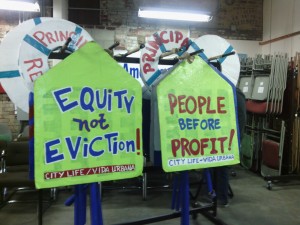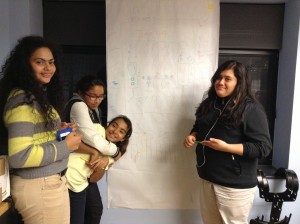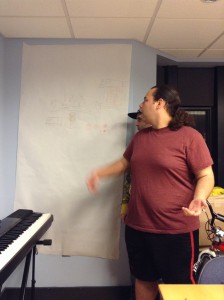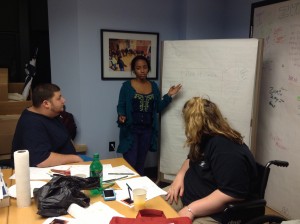Yesterday, we had our second meeting at CL/VU. The original plan was to join in on the last half hour of their staff meeting to get feedback from the staff on our initial project ideas. However, since it was the National Day of Mourning, the staff meeting was canceled. But that didn’t set us back! Thankfully, Steve Meacham, the Organizing Coordinator, and Dave Burt, the Special Projects Assistant, were able to join in on our meeting to engage in another exciting and productive brainstorming session.
Over the past week, we came up with 8 potential project ideas and presented them to Steve and Dave at the meeting. All of us at the meeting got hooked on one idea in particular that could tie together the three CL/VU campaigns, and promote a larger narrative around the housing crisis. Although the idea still needs to be vetted by the rest of the staff, we spent our meeting working to expand that idea and incorporate the other ideas we had come up with. We decided we would work to create and plan a large carnival. Wait…A carnival? How can a carnival challenge and shift the dominant narrative around the housing crisis? Stick with us for a moment…
Carnival games promise a fun time and a big prize. However, how many of us have ever won a carnival game? How much money have we wasted trying to get the big stuffed animal prize? A lot. How many have actually gotten the big stuffed animal prize? Very few. Why? Because carnival games are rigged so that people are unable to win. Similarly, the housing market promises a giant reward (namely, stability and equity), but the system is set up so that people don’t win. Unlike a carnival game, however, people’s life savings and hard work go into the process of “playing the game.” However, a fair market is supposed to be fair; not a carnival game.
Playing on this idea, we hope to plan and create a large carnival in the spring. The purpose of the carnival would be to help educate people about the housing crisis and illustrate how we are all pawns in a larger game. My hope is that the carnival will provoke questioning about our institutions and system, build a movement that breaks habits of inaction and, ultimately, creates a new collective consciousness that not only challenges, but also shifts the dominant narratives around the housing crisis to stimulate action. I especially think it will be important to have the carnival strongly tie into City Life/Vida Urbana’s organizing work, so that people don’t just leave and say, ‘that was nice.’ There needs to be a direct connection established between the carnival and how people can get involved in CL/VU’s work. We are, of course, still working through how it would look, but what we know for sure is that we want it to somehow tie into the policy recommendations CL/VU wants to give to the newly elected mayor. We hope that the mayor will be present on the day we hold the carnival, as well as other relevant stakeholders.
However, to promote the carnival and pilot our ideas, we plan to hold a series of small events throughout this semester in Boston/Cambridge. We want to see how people respond to our games. A few ideas emerged yesterday of smaller games we can pilot:
-
Exaggerate and give hula hoops to bankers and tiny hoops to regular people
-
Game of musical chairs – chairs disappearing showing how homes have disappeared
-
Hall of mirrors to see how distorting the effects of the market can be
A few other ideas that emerged from yesterday’s meeting are to work with artists to create a new magician caricature who can serve as the carnival’s mascot, as well as the mascot for a new, larger campaign around de-commodifying housing; develop a ‘virtual carnival’ to help promote the event that could also serve as a work product of this class; and have the carnival become a traveling carnival — working its way to different homes/spaces in the Boston area, or can even be a replicable model that other cities could readily adopt — to build a larger movement and awareness around the housing crisis. Nothing is set in stone, but we are making progress, and I am really enjoying our collaborative thinking process.




